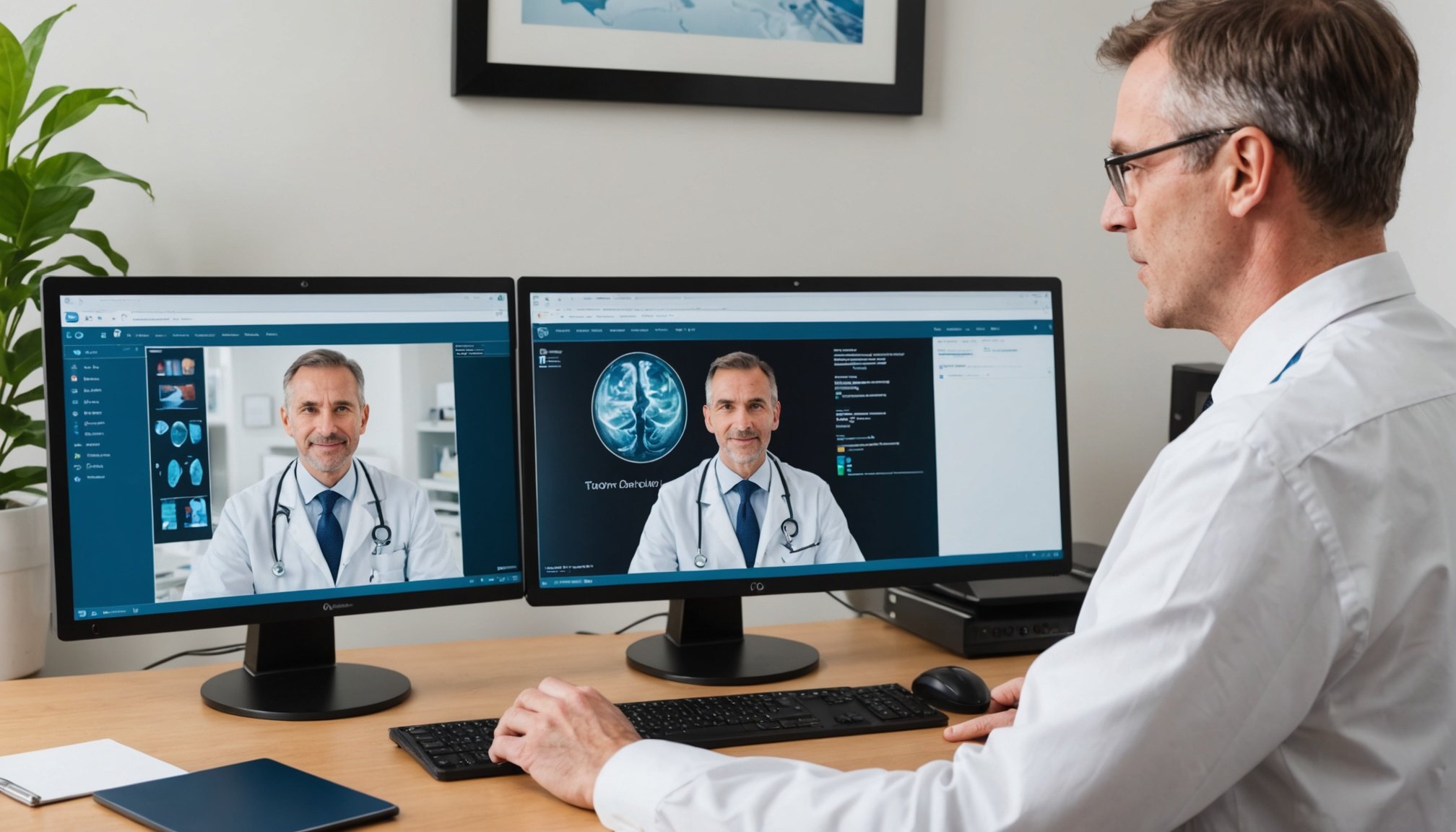The Role of Telemedicine in Prostate Cancer Follow-Up Care
Telemedicine has transformed the landscape of prostate cancer care, offering both patients and healthcare providers unprecedented convenience and efficacy. Through virtual consultations and remote monitoring, patients experience streamlined follow-up care without the frequent need for physical visits. This shift is especially significant for those living in remote areas or with mobility challenges, providing them with timely access to urologists.
Recent trends among urologists in the UK show a significant increase in the adoption of telemedicine for patient follow-up. This adaptation not only supports the ongoing management of the disease but also facilitates quicker reactions to patient needs and symptoms as they arise. The flexibility of virtual care allows doctors to monitor health metrics, adjust treatment plans swiftly, and interact with patients, fostering a sense of security and continuity in their care.
Also read : Exploring Innovative Techniques in Peritoneal Dialysis by Leading UK Nephrologists
The benefits of telemedicine for patients undergoing prostate cancer follow-up are manifold. Patients benefit from reduced travel expenses and time, and it enhances their comfort by alleviating the stress associated with in-person hospital visits. Moreover, the data-driven nature of telemedicine aids urologists in maintaining thorough and accurate clinical records, improving decision-making and outcomes.
Benefits of Telemedicine for Urologists and Patients
Increasingly, telemedicine is revolutionizing healthcare by enhancing patient engagement and healthcare efficiency, particularly within the field of urology.
Additional reading : Exploring the Cutting-Edge Innovations in Robotic Surgery for Gynecological Procedures: A Guide for UK Surgeons
Improved Access to Care
Telemedicine bridges geographical gaps, offering patients, even in remote locations, access to specialized urologists. This alleviates the need for extensive travel and enables faster consultations, ensuring that patients receive timely assessments and treatments. By leveraging technology, patients experience elevated convenience as they seamlessly connect with their healthcare providers directly from their homes.
Enhanced Patient Engagement
Telemedicine fosters improved patient engagement by promoting open communication channels between patients and urologists. This encourages patients to be more proactive in their healthcare journey, leading to better adherence to follow-up schedules. The ease of virtual consultations makes it simpler for patients to raise concerns or queries, ultimately strengthening the doctor-patient relationship.
Increased Healthcare Efficiency
Utilizing telemedicine increases healthcare efficiency by streamlining the consultation process. Urologists can manage their schedules more effectively, accommodating more patients within shorter timeframes. Remote consultations eliminate waiting room time, enabling a swift, flexible approach to patient care. The resultant efficiency frees up valuable resources and enhances overall healthcare delivery, benefiting both practitioners and patients alike.
Telemedicine Tools and Platforms Used by Urologists
The advent of digital health solutions has transformed the way urologists interact with patients, leveraging modern telemedicine tools to deliver efficient care.
Popular Telemedicine Platforms
Currently, consultation platforms like Doxy.me, Zoom for Healthcare, and Teladoc facilitate virtual visits. These platforms offer secure video conferencing, helping urologists conduct consultations efficiently. They ensure compliance with privacy regulations, providing patients with a seamless and safe experience.
Mobile Health Applications
Urologists increasingly use mobile health applications such as HealthTap and uMedico to connect with patients on-the-go. These apps enable patients to schedule appointments, receive reminders, and access educational resources. For practitioners, mobile apps often provide tools for managing patient information and improving engagement through real-time communication.
Remote Monitoring Technologies
Remote monitoring technologies play a vital role in patient care. Devices like wearable bladder scanners or connected urine flowmeters allow real-time monitoring of patients’ conditions. These technologies significantly enhance urologists’ ability to track progress and make informed decisions without the need for frequent in-person visits.
- Integration with Electronic Health Records (EHRs): Ensuring a seamless transition of patient data from telemedicine platforms to EHRs promotes continuity of care. This integration enables urologists to maintain accurate records, improving diagnosis and treatment planning.
Case Studies and Statistics on Telemedicine Efficacy
The growing field of telemedicine has proven to be a powerful tool in enhancing healthcare delivery. By examining numerous case studies, we gain insights into improved patient outcomes. These studies often emphasize quicker disease management and increased accessibility.
Successful Implementation Examples
Telemedicine in the UK has seen remarkable success, with several case studies highlighting its potential. For example, a specific NHS initiative enabled remote monitoring of chronic illness patients, significantly reducing hospital visits. The convenience and efficiency in managing patient care remotely contributed to heightened satisfaction and compliance.
Statistical Outcomes
Statistics reveal a clear trend of improved patient outcomes with telemedicine. A comprehensive study showed a 30% decrease in emergency room visits due to consistent telehealth appointments. Moreover, telemedicine efficacy was underscored by a 25% improvement in management of chronic conditions like diabetes. These statistics illustrate tangible benefits for healthcare systems.
Lessons Learned
An analysis of these implementations provides crucial insights. Key takeaways include the importance of integrating telehealth into existing care pathways thoughtfully. Future practices should focus on ensuring technology accessibility and training healthcare professionals adequately. This approach maximizes the benefits of telemedicine, shaping a more efficient and patient-focused healthcare landscape.
Guidelines for Urologists Implementing Telemedicine
The integration of telemedicine guidelines is crucial for urologists aiming to offer remote services effectively. Understanding UK regulations is essential, as these frameworks ensure legal compliance and patient confidentiality. Urologists must be acquainted with the General Data Protection Regulation (GDPR) and the standards for Electronic Health Records (EHRs), focusing on maintaining the integrity and privacy of patient data.
Regulatory Considerations
Key regulatory considerations include adherence to GDPR, which mandates data protection and privacy. Urologists are encouraged to stay informed about local laws and updates in telemedicine to safeguard themselves and their patients. It’s imperative to keep detailed records of patient consultations and obtain explicit consent for telemedicine interactions.
Best Practices for Platforms
When choosing telemedicine platforms, urologists should evaluate the security features and usability of each option. Platforms should provide reliable video quality and have robust encryption to protect sensitive information. Regular system updates and staff training improve service quality and patient satisfaction.
Patient Education and Support
Educating patients is vital to the successful implementation of telemedicine services. Urologists should offer clear instructions and technical support, which include:
- Creating easy-to-follow guides
- Offering live demonstrations
- Providing accessible customer service
Through these steps, patients can be empowered to utilize telemedicine confidently, ultimately enhancing their healthcare experience.
Challenges and Considerations in Telemedicine for Prostate Cancer
When considering telemedicine as a solution for prostate cancer care, it’s important to acknowledge the various challenges and considerations involved.
Technical Barriers
Telemedicine services often encounter significant technical barriers. Patients may face difficulties due to unreliable internet connections or a lack of access to necessary devices. These barriers can hinder the effectiveness of remote consultations and lead to a potential healthcare barrier.
Patient Demographics and Access Issues
Patient access is further complicated by varied demographics. Individuals from rural areas or lower socioeconomic backgrounds might experience a digital divide, limiting their ability to benefit from telemedicine. Such disparities highlight an inherent access issue within healthcare systems, emphasizing the need for solutions to improve inclusivity.
Maintaining Data Security and Compliance
Ensuring the security of patient data in telemedicine is crucial. Patients must feel confident that their private health information remains confidential. Healthcare providers must adhere strictly to compliance regulations to safeguard sensitive data, which is a significant consideration. Meeting these requirements helps maintain patient trust, a pillar of effective telemedicine practice.
Future of Telemedicine in Urology
The future of telemedicine in urology is filled with exciting possibilities that promise to revolutionize both patient care and healthcare delivery. Predictions suggest that telemedicine will continue to evolve, embracing cutting-edge urology innovations to offer more efficient and accessible medical services. As technology advances, it is likely that remote monitoring devices, powered by artificial intelligence, will play a significant role in follow-up care, ensuring timely interventions.
In the realm of evolving healthcare, these technological advancements could enable real-time data collection from patients, providing urologists with vital information to make fast, informed decisions. This capability not only improves patient outcomes but also reduces the need for physical consultations, which can be inconvenient for patients with mobility issues or those living in remote areas.
As telemedicine becomes more integral to urology, the importance of ongoing training and adaptation for urologists cannot be overstated. Professionals will need to stay abreast of the latest technologies and methodologies to provide the highest standard of care. This might involve specialized training sessions or continuous learning programs focused on digital tools and platforms.
In summary, the future of telemedicine in urology is poised to bring about significant changes, emphasizing the importance of integrating technology with comprehensive and adaptive training for healthcare professionals.











